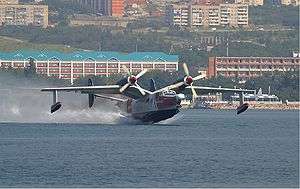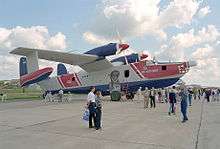Beriev Be-12
| Be-12 Chayka | |
|---|---|
 | |
| Be-12P-200 at Gelendzhik in September 2004 | |
| Role | Maritime patrol aircraft |
| Manufacturer | Beriev OKB |
| First flight | October 1960 |
| Introduction | 1960s |
| Status | Operational (in small numbers) |
| Primary user | Soviet Naval Aviation |
| Number built | 143[1] |
| Developed from | Beriev Be-6 |
The Beriev Be-12 Chayka ("Seagull", NATO reporting name: Mail) is a Soviet turboprop-powered amphibious aircraft designed for anti-submarine and maritime patrol duties.
Design and development
The Beriev Be-12 was a successor to the Beriev Be-6 flying boat, whose primary roles were as an anti-submarine and maritime patrol bomber aircraft. Though tracing its origins to the Be-6, the Be-12 inherited little more than the gull wing and twin oval tailfin configuration of the older aircraft. The Be-12 had turboprop engines, which gave it an improved speed and range over the Be-6.[2] The Be-12 also had retractable landing gear, which enabled it to land on normal land runways, as well as water.
The Be-12 was first flown on October 18, 1960 at Taganrog airfield, and made its first[2] public appearance at the 1961 Soviet Aviation Day festivities at Tushino airfield. A total of 150 aircraft were produced, in several variations, with production ending in 1973.
Operational history
.jpg)
The Be-12 entered service with Soviet Naval Aviation, or AV-MF (Aviatcia Voenno-Morskogo Flota), in the early 1960s in the maritime patrol role, and is one of the few amphibians still in military service in the world. Initially its role was ASW patrol, but when newer missiles enabled United States Navy submarines to launch from further offshore it was converted to the search and rescue role (Be-12PS). Small numbers are still in service. After the dissolution of the Soviet Union, some aircraft were converted to water bombers for the suppression of forest fires. During development of the Beriev Be-200 unique fire-fighting equipment was tested using a specially modified Be-12P, code-named "12 Yellow". After installation of the fire-fighting system, the aircraft was registered as RA-00046 and given the designation Be-12P-200. This modified Be-12 was also used to trial firefighting operations envisaged for the Be-200.[3] According to figures released in 1993, the Russian Navy had 55 aircraft in service. By 2005 this had dropped to 12,[1] and by 2008 there were only nine aircraft still in service.[4] A surviving Be-12 is preserved at the Central Air Force Museum at Monino, outside of Moscow. Other examples exist at the Ukraine State Aviation Museum at Kiev, Ukraine and that the Taganrog Air Museum, in southern Russia.
Variants


- Be-12
- Twin-engined maritime reconnaissance, anti-submarine warfare flying-boat. 2 prototypes and 130 production airframes built.
- Be-12EKO
- Projected ecological reconnaissance version. Not built.
- Be-12I
- Projected scientific research version designed in 1991. Not built.
- Be-12LL
- Conversion for testing the 3M-80 'Moskit' anti-shipping missile. Nose radar replaced with missile seeker head. One aircraft converted in 1980.
- Be-12N
- ASW version fitted with new sensors, avionics, MAD sensor and Nartsiss search/attack system. 27 aircraft converted.
- Be-12Nkh
- Utility transport, experimental passenger transport version. Military equipment removed, additional windows fitted. 2 built, both converted from Be-12.
- Be-12P
- Firefighting version. One 4,500 l tank and two 750 l tanks installed. Four aircraft converted in 1992.
- Be-12P-200
- Technology demonstrator for the Beriev Be-200. Fire-fighting configuration. One aircraft converted.[3]
- Be-12PS
- Maritime Search and rescue version. Life rafts and survival equipment carried. 6 crew. 10 built new, 4 converted from Be-12.
- Be-12SK
- One aircraft converted in 1961 for use in SK-1 nuclear depth charge tests.
- Be-14
- All weather, day/night SAR version. Additional SAR and medical equipment. 6 crew. AI-20D engines. One built.
- M-12
- Stripped-down Be-12 used for record-setting flights. 2 Crew. Later returned to standard configuration.
Operators
- Egyptian Air Force operated two or three Be-12s circa 1970, crewed by Soviet personnel, to maintain surveillance on the United States Navy's 6th Fleet in the Mediterranean.[5]
- Russian Naval Aviation received ex-Soviet Union aircraft. Nine Aircraft still in operation with the Black Sea Fleet.[4]
- Soviet Naval Aviation passed their aircraft to successor countries: Russia and Ukraine.
- Ukrainian Naval Aviation received ex-Soviet Union aircraft.
- Vietnam People's Air Force - 4 aircraft were exported to Vietnam in 1981.
Specifications (Be-12)
General characteristics
- Crew: Four
- Length: 30.11 m (98 ft 9 in)
- Wingspan: 29.84 m (97 ft 11 in)
- Height: 7.94 m (26 ft 1 in)
- Wing area: 99.0 m² (1,065 ft²)
- Empty weight: 24,000 kg (52,800 lb)
- Loaded weight: 29,500 kg (64,900 lb)
- Max. takeoff weight: 36,000 kg (79,200 lb)
- Powerplant: 2 × Ivchenko Progress AI-20D turboprops, 3,864 kW (5,180 hp) each
Performance
- Maximum speed: 530 km/h (290 kn, 330 mph)
- Range: 3,300 km (1,800 nmi, 2,100 mi)
- Service ceiling: 8,000 m (26,247 ft)
- Wing loading: 298 kg/m² (61 lb/ft²)
- Power/mass: 260 W/kg (0.16 hp/lb)
Armament
- 1,500 kg (3,300 lb) of external stores, including bombs, depth-charges and torpedoes
See also
- Related development
- Aircraft of comparable role, configuration and era
- Related lists
References
| Wikimedia Commons has media related to Beriev Be-12. |
Notes
- 1 2 Aeroflight - Beriev Be-12 'Mail'
- 1 2 Jane's All The World's Aircraft. 1975–1976. pp. 488–489. ISBN 0-354-00521-9.
- 1 2 Gordon, Sal'nikov and Zablotskiy 2006, pp. 79-80.
- 1 2 RIA Novosti news agency - Russian Navy to receive 4 new amphibious planes by 2013
- ↑ Air International Magazine, August 1995, p. 88; example photo, p. 83.
Bibliography
- Yefim Gordon, Andrey Sal'nikov and Aleksandr Zablotskiy (2006) Beriev's Jet Flying Boats. Hinckley, UK: Midland Publishing. ISBN 1-85780-236-5
- "Beriev Be-12 'Mail'". aeroflight.co.uk. 2005-08-05. Retrieved 2008-09-11.
- "Beriev". Aviation.ru. 2004-03-30. Retrieved 2006-08-14.